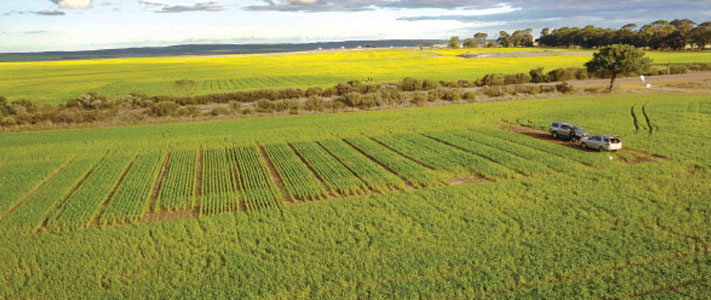New seed treatment benefits ‘obvious’ in south-east WA trial
About
-
Date
01 December, 2017
About
Date
01 December, 2017

South East Agronomy Services Consultant Luke Marquis is conducting a seed treatment trial at Cascade in the region in conjunction with his colleague, Research Manager with South East Agronomy Research, Sarah Belli.
Luke said the results so far had shown stark differences between treated and untreated plots, with a new seed treatment product impacting crop bulk, vigour and colour.
The trial is located on Simon and Jon Stead’s property in a paddock with gravel loam over clay soils. It was sown to Mace wheat on May 8, also following Mace wheat last season. It received a pre-emergent herbicide application of 2 L/ha of paraquat, 2 L/ha of Treflan® and 118 g/ha of Sakura®.
The main seed treatment product being tested is EverGol® Energy from Bayer, a new broad-spectrum fungicidal seed treatment using penflufen and the systemic activity of prothioconazole and metalaxyl. It is expected to be registered early in 2018.
The trial plots included untreated; no seed treatment with two Aviator® Xpro® foliar applications at 300 mL/ha; EverGol Energy as a seed treatment at 260 mL/100 kg of seed (with and without Aviator Xpro foliar treatments at 300 mL/ha and/or 500 mL/ha); and EverGol Energy as a seed treatment at 130 mL/100 kg of seed with 200 mL/ha of EverGol Energy banded in-furrow (with and without Aviator Xpro foliar treatments at 300 mL/ha and/or 500 mL/ha).
“Four weeks after sowing, we struggled to see any differences between treatments, but at six to eight weeks after sowing, you could see a distinct increase in biomass compared to the untreated,” Luke said.
“There was almost a uniform step-up from untreated to the seed treatment plot at 260 mL/100 kg, then it went up again in biomass, overall health and vigour of the crop to the 130 mL/100 kg treatment plus the 200 mL/ha in-furrow.”
Previous trials have also demonstrated EverGol Energy’s ability for broad-spectrum control of a range of diseases in wheat, barley, oats and triticale, including flag smut (seed and soil borne), loose smut, covered smut, common bunt, rhizoctonia, pythium, crown rot, fusarium head blight and white grain disorder.
It has also shown good suppression of other diseases including rhizoctonia, pythium, fusarium head blight and crown rot. Anticipated registration for in-furrow application will add crownrot and pythium suppression in wheat, triticale, barley and oats. The recommended rate range for EverGol Energy is 65-260mL/100 kg of seed.
Luke said rhizoctonia was a common burden for growers in the area and he recognised the potential of EverGol Energy to help manage the fungal disease.
He said he selected the trial site due to its soil type and crop history, knowing it would be more susceptible to rhizoctonia. “You can certainly see with the evenness of the Evergol Energy treated plots, that there’s been a response to the suppression of rhizoctonia. There was quite a marked difference in the evenness of the crops.’’
“Especially going wheat-on-wheat and on these soils, the conditions all point towards rhizoctonia, so to not have seen it so far has been very surprising.” Luke said application of Aviator Xpro, which uses bixafen and
prothioconazole as its active ingredients, at very early tillering also prevented yellow spot from developing.
He said this was significant, especially considering the paddock was wheat-on-wheat, which was usually a precursor for yellow spot. The registration of Aviator Xpro for control of yellow leaf spot in wheat is expected in June 2018. Always use Aviator Xpro according to the most recent registered label.
“Compared with the farmer-sown crop in the paddock, which didn’t use any seed treatment, there was a distinct difference to the trial plots,” Luke said.
“I took Jon and Simon Stead down to show them and they were quite impressed at the results – and that’s just the visual impact, without showing them any other assessments. “Often with seed treatment trials, you can struggle to extract much out of them initially, visually-speaking, but that’s why this one was quite exciting, because the differences were so obvious.
“The crop bulk, vigour, colour and evenness were all markedly improved in the EverGol Energy-treated plots.”
An application for registration of EverGol Energy has been made. At the time of publication, this product is not registered.




